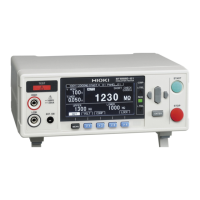Appx.4
Inuence of Capacitive Load
Appx. 4 Inuence of Capacitive Load
Pure resistance is assumed in the instrument specications, however, some
capacitance components are contained in the equipment to be measured. The higher
the resistance is (small detected current), the more variability the inuence of a
capacitive load causes.
Inuence on output voltage rise
The charge current of the instrument is 1.8 mA (less than 20 mA).
If a capacitive load, such as a capacitor, is connected, the time required for the output voltage to
rise is affected. The time is calculated as follows.
CV = it (C: Capacitance (F), V: Voltage (V), i: Current (A), t: Time (s))
Example: If a test voltage of 500 V is applied to a 1.0 µF capacitor, the time required for the
output voltage to rise to 500 V is approximately 0.28 s, calculated by (1.0 µF × 500
V)/1.8 mA.
If the equipment to be measured contains capacitive components, extend the test
duration.
Repeat accuracy
Test condition: Connect and measure the resistance load and capacitive load in parallel. (See
the gure below.)
(A lm capacitor is used.)
Instrument
Connection diagram
As the test data shows below, measurements were performed for each resistance range and
variation in the average of 100 measurements was calculated. The measured values were
obtained with the capacitor charged.
(Test duration: Max. 100 s)

